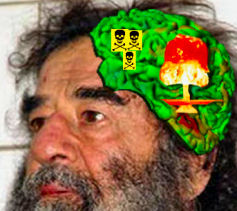 Quote: “There comes a point where the absence of evidence does indeed become the evidence of absence.” Senate Intelligence Committee report, dismissing links between Iraq and al-Qaeda.
Quote: “There comes a point where the absence of evidence does indeed become the evidence of absence.” Senate Intelligence Committee report, dismissing links between Iraq and al-Qaeda.
Figure of Speech: chiasmus (key-AS-mus), the criss-cross figure. Chiasmus is the Greek letter “X.”
Before the war, our spies failed to find links between Bin Laden and Hussein — proving, the White House concluded, that we had bad spies. The Senate Intelligence Committee now says otherwise: Not only did Saddam Hussein not harbor terrorists, he actually tried to arrest al-Qaeda members.
The report rhetorically bitch slaps Donald Rumsfeld, who said before the war that “the absence of evidence does not mean evidence of absence.” Both Rummy’s version and the Senate’s use a chiasmus, Figaro’s very favorite figure. It takes a phrase or clause and repeats it in mirror form. Use a chiasmus to seize your opponent’s argument and flip it onto its back.
The White House is now forced to reach this conclusion: Senators are bad people.
Snappy Answer: “Ask not how the evidence makes you look, ask how you make the evidence look.”
 Figaro
Figaro